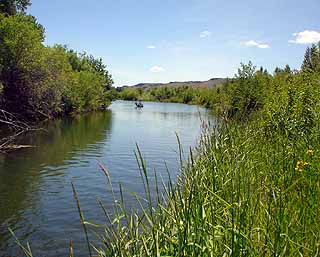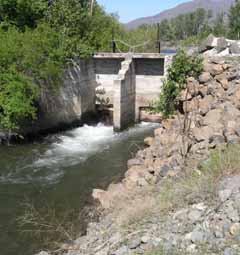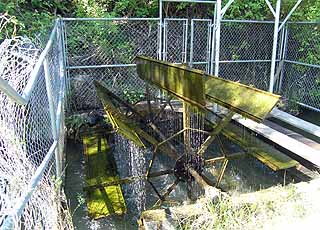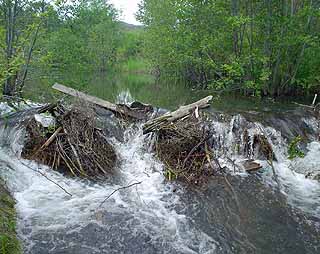
Surveys
DJC.COM
July 28, 2005
Farmers, government team up to save fish
Jones & Stokes

Photos courtesy Jones & Stokes
About $1 million is needed for improvements to the South Naches Channel's aging water distribution system. A plan to get those funds would also help fish.
|
A unique partnership has been formed in the Yakima area that will benefit both fish and farmers.
The project in the South Naches Irrigation District will address major aspects of the district's operations as part of a comprehensive district-wide plan to ensure that future operations will comply with the Clean Water Act and the Endangered Species Act.
Many irrigation districts in Eastern Washington are facing possible regulatory challenges as a result of their operations. Normally, this situation that pits water rights and farmers against fish. What makes the South Naches district's approach unique is that it is one of a handful of districts in the state that is testing an innovative approach to balancing the competing demands of farming and environmentalregulations.
The new approach is known by the unwieldy acronym CIDMP (comprehensive irrigation district management plan), and is founded on cooperation and partnership.
"This groundbreaking process ... does not establish a set of mandatory regulations or standards to be inflexibly applied," Thomas G. Myrum, executive director of the Washington State Water Resources Association, explained last month to the House Resources Subcommittee on Water and Power in Washington, D.C.

The main diversion structure off the South Naches River was built during the First World War. It is targeted for rehab or replacement.
|
Myrum's association represents all irrigation districts in Washington state.
Updating irrigation systems
Other agencies support the new approach, too.
"This process is a unique voluntary and incentive-based approach to improving irrigation district operations in response to both Endangered Species and Clean Water Act concerns," said Greg Wright with the Washington State Department of Agriculture, which is overseeing the pilot program.
"The ultimate goal of the process," Myrum told the subcommittee on Capitol Hill, "is to maintain agricultural viability, protect and enhance our state's natural resources and help in the recovery of salmon, bull trout and other listed species." Wright also noted that the process will assure proponents that completing their management plans will allow them to achieve compliance with the ESA and CWA.
That's a benefit that the South Naches Irrigation District appreciates. "Right now, it's difficult for us to maintain our system and still meet state and federal regulations," said Paul Kauzlarich, manager for the South Naches Irrigation District. "If we can modernize our irrigation system to provide water to our customers more efficiently, and, at the same time, reduce the impact to fish, this is a win-win solution."
The draft plan for the South Naches district, being developed with farmers and agencies by the Bellevue office of Jones & Stokes, proposes a variety of significant changes to the way the district manages water to minimize the adverse impacts on salmon. This includes improving a 90-year-old structure that diverts water from the river, installing a pressurized irrigation distribution system in some places, removing a dysfunctional fish screen, and developing alternatives to using herbicides to manage aquatic weeds that choke the system in the summer months.
Yakima-based Huibregtse, Louman Associates is on board to assess the engineering viability of the project.
Pilot project

This fish screen on the South Naches Channel was built in the 1930s. Plans are to rehab or bypass it.
|
Many farmers, and the Yakama Nation which owns close to 20 percent of the district's 1,811 acres of irrigated land, are also enthusiastic about possible future efforts to create and enhance fish habitat. One landowner, Steve Younker, is excited about improvements to his land that will create duck habitat, and off-channel refuge areas for fish.
Other Eastern Washington irrigation districts are watching the pilot project with interest because the South Naches Irrigation District shares many of the same problems they face.
The South Naches system has been in use since the 1880s, and consists of open ditches, canals and wooden flumes. The system is gravity-fed and diverts 65 cubic feet per second — a flow that would fill three 10,000-gallon swimming pools each minute — out of the river from April through October, with a much smaller diversion during the winter to provide stock watering and to keep water in the fish-bearing South Naches Channel. In the past, farmers were free to take as much water from the diverted flow as they needed.
The aging system poses a range of problems for fish. Most serious was a 70-year-old fish screen serving one ditch. Converting the aging distribution system to a more efficient pressurized system will also allow more water to flow on a year-round basis to support fish and wildlife habitat in the channel.
As with other irrigation districts, South Naches has a relatively small budget, about $40,000 a year, and funding for the estimated $1 million in improvements will need to be secured. That's where the draft CIDMP, funded by the Washington Department of Agriculture, comes in. Approval of the plan will help trigger funds from a variety of sources for the proposed improvements, at which point the formal environmental permitting process would get under way.
An earlier study of the feasibility of a pressurized irrigation system had been completed in 1994 with money that the state Legislature had made available for irrigation districts to engage in long-term planning. That plan lay dormant until representatives from Jones & Stokes, which had been involved in comprehensive irrigation district management plans elsewhere in the state, approached the South Naches district.

Beaver dams can cause flooding on the South Naches Channel, but aren’t dangerous to fish.
|
Our firm explained the benefits of the CIDMP program to the district board and how it could address the regulatory problems they were facing. The farmers were enthusiastic from the start, and so were the agencies, in great part because the planning process works to achieve can-do solutions on the ground, instead of battles in the court room.
"The South Naches project is focused on meeting the goals of all parties in a cooperative and mutually beneficial manner," said the Department of Agriculture's Wright.
This marks a significant shift from the previous approaches to resolving endangered species issues. Agricultural and environmental interests have long been at odds, and the battle for water rights has been on a collision course.
The plan for South Naches promises to benefit both sides by using available water more efficiently and addressing the major problems posed by an aging irrigation system. And, once it's approved, you can be sure that a lot more farmers in Eastern Washington, and elsewhere in the state, will be looking closely at comprehensive irrigation district management plans.
Christopher Earle, Ph.D., is a recognized regional expert in riparian systems ecology and forest ecology.
Other Stories:
- Green buildings can spark economic growth
- Whitewater parks move into the mainstream
- Momentum is building to reduce global warming
- Turning waste into environmental, social good
- Let the sunshine in, efficiently
- The hazards of flicking on a light switch
- A road map for Columbia Basin's future
- Canada: A lesson in salmon recovery planning
- Better mapping may change development rules
- What makes a green consumer?
- Seattle law firms end their paper chase
- Food industry puts energy efficiency on the menu
- A solution to Hood Canal's lurking pollution?
- Stretching Washington's water supply
- Saving salmon: Now the hard work begins
- Seattle finds gold with sustainable strategies
Copyright ©2009 Seattle Daily Journal and DJC.COM.
Comments? Questions? Contact us.